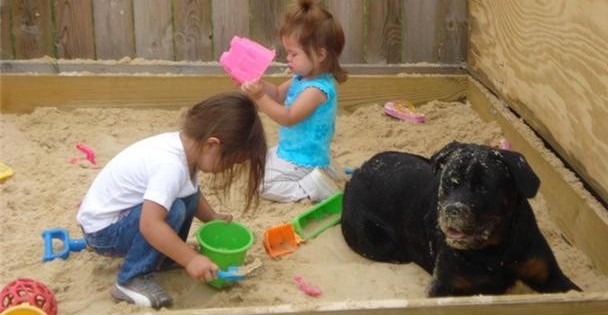General Appearance
Dunjo Von Shambala BH, AD, Mag, CGC BH, AD, Mag, CGC
 “The Rottweiler is a medium to large size, stalwart dog, neither heavy nor light and neither leggy nor weedy. His correctly proportioned, compact and powerful build leads to the conclusion of great strength, agility and endurance.” (ADRK German Rottweiler Breed Standard)
“The Rottweiler is a medium to large size, stalwart dog, neither heavy nor light and neither leggy nor weedy. His correctly proportioned, compact and powerful build leads to the conclusion of great strength, agility and endurance.” (ADRK German Rottweiler Breed Standard)
Function Follows Form.
A correctly bred and correctly produced Rottweiler should exude power and strength. He should have sufficient bone and substance and a very compact frame. Correct physical attributes for the Rottweiler do much more than make the Rottweiler the beautiful, majestic dog that has captured hearts around the world. Every single aspect of his physical appearance that we love was bred into the Rottweiler with careful consideration to the jobs we would ask of him. The large, strong, prominent head with a full, powerful muzzle give the Rottweiler the strongest bite force of any domestic breed of dog. If the head is lacking in type- if the muzzle is not full, if the topskull is not sufficient, if the bite is not correct, then the Rottweiler loses all of the biteforce associated with the size and structure of his head. If the chest is not wide and deep, then the Rottweiler will not have the lung capacity or stamina required of a herding and working dog. If the front and rear angles are not correct, he will not have fluid, powerful movement. If he is lacking in bone or substance, then he will not have the strength and hegemony required to challenge a 2000 pound bull or absorb the impact of an attacker. On this page, we will thoroughly discuss correct conformation from head the tail. I will provide photos and illustrations of correct and incorrect examples and potential functional and health issues associated with the faults. 
1. Cheek
2. Mouth Angle (Jawline)
3. Muzzle and lips
4. Nose
5. Stop
6. Ear
7. Neck
8. Scapula/Shoulder (the withers is the highest point of the shoulder blade)
9. Back/Top Line
10. Lumbar (the portion of the back associated with the lumbar portion of the spine is called the loin)
11. Pelvis
12. Tail
13. Hip Joint
14. Femur (Upper Thigh)
15. Fibia (Lower Thigh)
16. Hock (Heel)
17. Rear Pasterns (Metatarsals)
18. Ankle
19. Phalanges (Toes)
20. Tibia (Lower Thigh)
21. Stifle (Knee)
22. Patella
23. 13th Rib
24. Ribs (13 pairs)
25. Brisket
26. Elbow
27. Forearm
28. Wrist
29. Carpals
30. Phalanges (Knuckles)
31. Pastern (Metacarpals)
32. Dew Claw
33. Ulna & Radius (Lower Arm bones)
34. Humerus (Upper Arm)
35. Shoulder Joint
Important Proportions
“The length of the body, measured from the sternum (breast-bone) to the ischiatic tuberosity, should not exceed the height at the withers by, at most, 15%.” (ADRK German Rottweiler Breed Standard) The means that the Rottweiler should have a square, compact frame without being leggy nor too long in the back.  The Rottweiler Head. I will start at his most noted feature, and one of my favorite attributes of the correctly bred Rottweiler- his head. The Rottweiler’s skull should be medium in length and broad between the ears. The forehead is moderately arched and the arch should be noted when viewed from the side. This is further accentuated with a deep, well defined stop. The easiest way to remember where the “stop” is on a Rottweiler is to remember that it is where the muzzle “stops” and the topskull begins. In the photo below, the stop is at the end of the black arrow (#4) and in this head is very deep and well defined. The occipital bones (back skull) should well developed without being too conspicuous. The zygomatic arch should have sufficient fill.
The Rottweiler Head. I will start at his most noted feature, and one of my favorite attributes of the correctly bred Rottweiler- his head. The Rottweiler’s skull should be medium in length and broad between the ears. The forehead is moderately arched and the arch should be noted when viewed from the side. This is further accentuated with a deep, well defined stop. The easiest way to remember where the “stop” is on a Rottweiler is to remember that it is where the muzzle “stops” and the topskull begins. In the photo below, the stop is at the end of the black arrow (#4) and in this head is very deep and well defined. The occipital bones (back skull) should well developed without being too conspicuous. The zygomatic arch should have sufficient fill. ![]()
1. Length of the skull (topskull and muzzle).
2. Width of the topskull.
3. Zygomatic arch
4. Muzzle length.
5. Muzzle
6. Length of the topskull
7. Lower jaw
8. Eyes
9. Gums
10. Teeth
11. Ears
12. Arch of the topskull
1. The total length of the skull is measured from the tip of the nose to the occiput. The occiput is a bony prominence at back/top of the skull that can be both seen and felt.
2. Topskull Width. The topskull should be wide and prominent with a moderate arch. This arch should be visible when viewed from the side.
![]() 3. The Zygomatic arch is the area under the eye. When this is not sufficient the dog is said to be “lacking fill under the eye”. If you have seen a Rottweiler that appears to be sunken in under the eyes, this is from insufficient fill under the eye or zygomatic arch. The Zygomatic arch has direct correlation with a correct muzzle. When the muzzle is not broad enough at the base, the zygomatic arch will be insufficient. In fig. 3, you can see where the zygomatic arch is located in the bone structure. This is also indicated with a white arrow (1) in fig. 2. The head in the photo to the right (fig. 2) has correct muzzle to topskull ratio, but because the stop is not well defined, the muzzle is narrow at the base and the dog is lacking fill under the eye, the head takes on more of a hound dog appearance rather than the correct, strong Rottweiler head.
3. The Zygomatic arch is the area under the eye. When this is not sufficient the dog is said to be “lacking fill under the eye”. If you have seen a Rottweiler that appears to be sunken in under the eyes, this is from insufficient fill under the eye or zygomatic arch. The Zygomatic arch has direct correlation with a correct muzzle. When the muzzle is not broad enough at the base, the zygomatic arch will be insufficient. In fig. 3, you can see where the zygomatic arch is located in the bone structure. This is also indicated with a white arrow (1) in fig. 2. The head in the photo to the right (fig. 2) has correct muzzle to topskull ratio, but because the stop is not well defined, the muzzle is narrow at the base and the dog is lacking fill under the eye, the head takes on more of a hound dog appearance rather than the correct, strong Rottweiler head.
4. Muzzle length is measured from the tip of the nose to the stop. A dog’s stop is literally where the muzzle “stops” and the topskull begins. Ideally, the breeder strives for a stop close to a 90 degree angle. In the Rottweiler, this important feature is usually one of the first things lost in poor breeding. The head becomes elongated and the steep, 90 degree angle is flatten out to the shallow slope typical of an Irish Setter. In the photo to the right (fig. 2), you can see the shallow slope of the stop in contrast to the deep indented stop in the head above (fig. 1). The muzzle should compromise 40% of the total length of the head with the topskull the other 60%. The nose is always black and should be well developed with relatively large nostrils and more broad than round. There has been a trend developing over the last decade towards a “super short” muzzle. My theory is that this is in rebellion to the terrible head type we have developed here in the US with indiscriminate breeding. This “extreme head type” was pioneer by MAMBO VON DER CROSSENER RANCH. Where as MAMBO had a more extreme head type, he still conformed to the breed standard. Now, more and more breeders continue to push the envelope. It should be noted that there will be inherent problems when attempts are made to go TOO SHORT on the muzzle. The first and most obvious problem will be the bite. A Rottweiler’s mouth must contain 42 teeth. You can only go so short on the muzzle and still accommodate 42 teeth. A lot of your EXTREME head type bloodlines will have higher numbers of bad bites (over bite or under bite- discussed further down on this page). The Rottweiler’s most important feature of his head is indeed his bite. He is capable of possessing the strongest bite force because of the CORRECT muzzle to head ratio. Where as the extreme head type might provide and exotic look, these dogs WILL NOT be able to perform as well. A shorter muzzle will equate with a smaller mouth, inability to get a full grip on a bite sleeve and loss of power in overall bite. A good breeder will seek to BALANCE beauty with function.
5. The muzzle MUST BE broad at the base for the head to be correct. In fig. 4, 5, and 6 (above), there are examples of different muzzle types. Fig. 4 is correct. Fig. 5 and fig. 6 are both too narrow. When the muzzle is not wide enough at the base, the dog will surely be lacking fill under the eye as well (as discussed in zygomatic arch/eye fill). The muzzle width at the base is a direct correlation to the pronunciation of zygomatic arch.
6. The length of the topskull is measured from the stop to the occiput to the stop and should compromise 60% of the total length of the head. 7. Lower jaw should be strong, adding to the power of the muzzle.  8. The Rottweiler’s eyes should be almond shaped and dark. The eyelids must be tight fitting with hair on the eye lid. There should be no ocular discharge. If the Rottweiler is too “wet” meaning too much loose skin (often associated with the Mastiff breed or St. Bernard), then the skin around the eyes can also be excessively loose. This can make the dog more susceptible to entropion or ectropion. Rottweiler eye color is another big issue in many bloodlines. Colors 1a through 2b are ideal. In Germany, the eye color is measured with an eye chart and if the dog’s eyes are not dark enough, the dog/bitch is NOT permitted for breeding. Unfortunately, there are no such requirements here in the USA. When a dog with slightly light eyes is bred to a bitch with light eyes, the resulting offspring will have even lighter eyes. Then you get the breeders advertising “rare hazel” or “rare yellow” eyed pups. They are incorrect, not rare; as a matter of fact, especially here in the US, CORRECTLY bred dogs are the ones that are rare!
8. The Rottweiler’s eyes should be almond shaped and dark. The eyelids must be tight fitting with hair on the eye lid. There should be no ocular discharge. If the Rottweiler is too “wet” meaning too much loose skin (often associated with the Mastiff breed or St. Bernard), then the skin around the eyes can also be excessively loose. This can make the dog more susceptible to entropion or ectropion. Rottweiler eye color is another big issue in many bloodlines. Colors 1a through 2b are ideal. In Germany, the eye color is measured with an eye chart and if the dog’s eyes are not dark enough, the dog/bitch is NOT permitted for breeding. Unfortunately, there are no such requirements here in the USA. When a dog with slightly light eyes is bred to a bitch with light eyes, the resulting offspring will have even lighter eyes. Then you get the breeders advertising “rare hazel” or “rare yellow” eyed pups. They are incorrect, not rare; as a matter of fact, especially here in the US, CORRECTLY bred dogs are the ones that are rare!
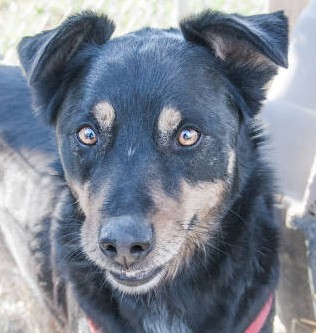

Of course both of the females above have several faults, but for the purpose of this discussion, we will focus on the eyes. They have extremely light “bird of prey” yellow eyes that are very distracting and detract from the strong, intimidating look the Rottweiler should portray. In contrast, notice how different the look that the dark eyes give.
DIESEL Von Gottschalk Crom Di Alaricus Rex
(at 11 years young and taken on Animal Planet set!)
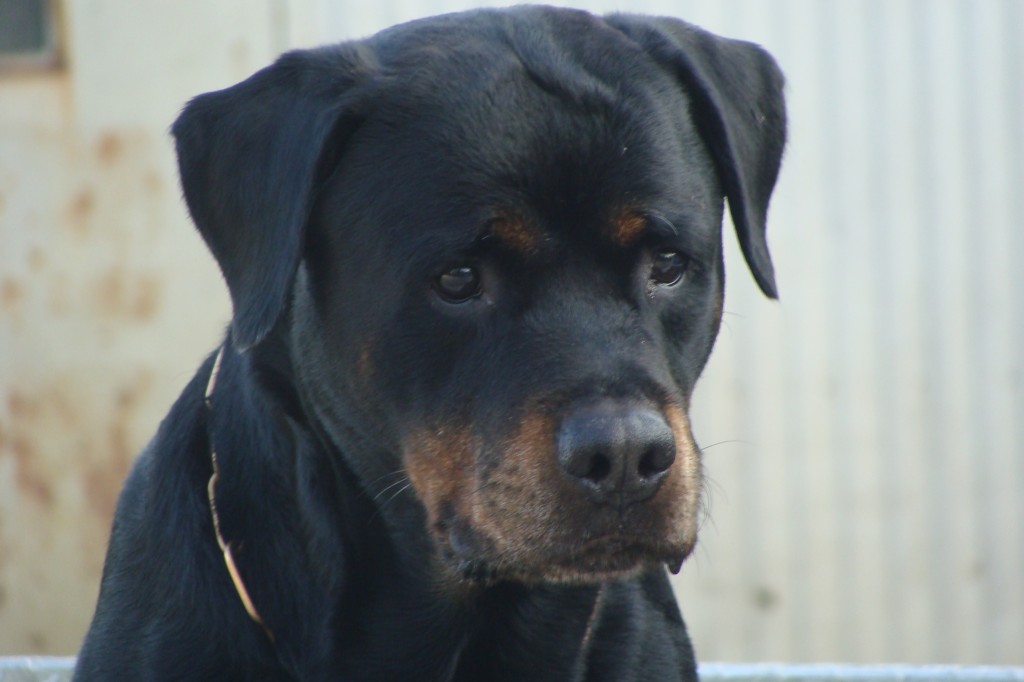
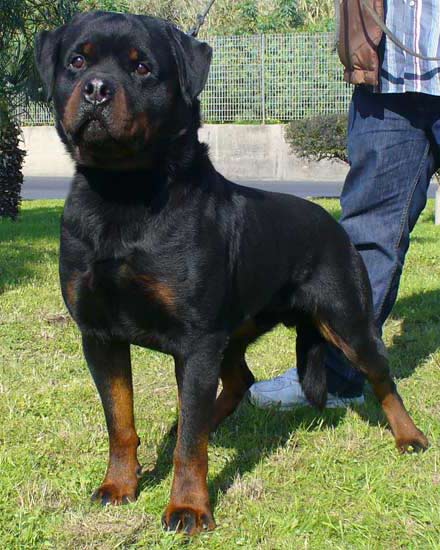
9. The Rottweiler’s gums should be very dark- as close to black as possible. Some pink mottling is acceptable per ADRK standard, however, if the gums are not dark enough or the pink splotches are excessive, the Rottweiler will NOT pass his breed suitability test. I have seen WAY TOO MANY dogs that COMPLETELY lack pigment in the mouth- known as “bubblegum pink mouth.” These dogs SHOULD NOT BE BRED. This is not the breed standard.
The “bubble gum” pink mouth in the female below does not have a bit a black in it and becomes the immediate focus of the face and head. Whereas the black mouth in Guardian Atlas Von Gottschalk add to the “Dark Night” look rather than distracting from his incredible head piece.
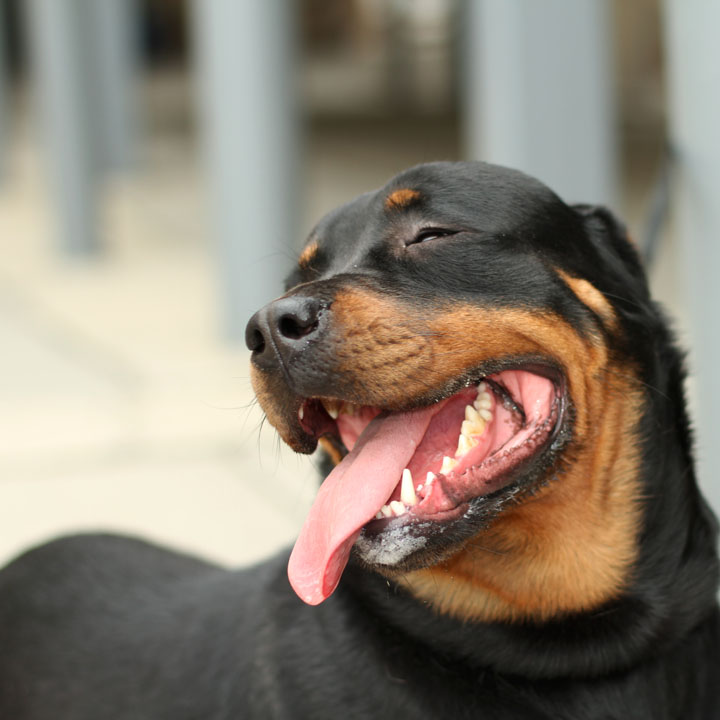

10. The rottweiler should have a complete scissor bite. Super short muzzle are the latest “fashion”. I think in an effort to abolish all the terribly bred, hound dog head types that everyone finally got tired of seeing. BE FOREWARNED, you can ONLY GO so short on a dog’s muzzle and still accommodate 42 teeth. When the muzzle is too short, not only do you start to limit the abilities of the dog (difficulty obtaining a good, full mouth bite on a sleeve) but you will also almost certainly begin to run into bite problems- overbite or underbite. Although maloccusions do not effect the overall health of the dog in most cases, a dog or bitch with an incorrect bite SHOULD NOT BE BRED as these are potentially genetic issues.  The most common missing teeth in Rottweilers are the P1, P2 and M3. The P1 and P2 (premolars) are small teeth directly behind the Canine teeth and the M3’s are the last molars in the upper jaw. A correct bite is not the same for every breed of dog. Some dogs are SPECIFICALLY bred to have an under or overbite (such as the Boxer, Bulldog, etc.). Dogs were bred to either fulfill a need or suit our taste. The Rottweiler was bred to be a working dog specifically with the ability to perform apprehension, search and rescue, personal protection, etc. Because of this, a correct scissor bite without any missing teeth is more than superficial beauty, it is essential for correct job performance. For this very reason, the bite is one of the FIRST THINGS a judge will check BEFORE the dog even walks the ring. In the photo above, 4 different bites are illustrated. The first is a correct scissor bite. Aptly named as the teeth close tightly and correctly like a pair of scissors. The second bite is a level bite. The level bite is neither an overbite nor an underbite, but rather where the top and bottom teeth meet exactly level with one another. This next illustration is an underbite. This is where there is a significant gap between the upper and lower jaws with the lower jaw being shorter. The final illustration is the converse of an underbite with the lower jaw being longer. This bite is, although a fault in Rottweilers, is the breed standard for English Bulldogs and Boxers amongst other breeds. This type of bite gives the English Bull dog an ideal grip on the nose of a Bull as it was bred for that specific purpose.
The most common missing teeth in Rottweilers are the P1, P2 and M3. The P1 and P2 (premolars) are small teeth directly behind the Canine teeth and the M3’s are the last molars in the upper jaw. A correct bite is not the same for every breed of dog. Some dogs are SPECIFICALLY bred to have an under or overbite (such as the Boxer, Bulldog, etc.). Dogs were bred to either fulfill a need or suit our taste. The Rottweiler was bred to be a working dog specifically with the ability to perform apprehension, search and rescue, personal protection, etc. Because of this, a correct scissor bite without any missing teeth is more than superficial beauty, it is essential for correct job performance. For this very reason, the bite is one of the FIRST THINGS a judge will check BEFORE the dog even walks the ring. In the photo above, 4 different bites are illustrated. The first is a correct scissor bite. Aptly named as the teeth close tightly and correctly like a pair of scissors. The second bite is a level bite. The level bite is neither an overbite nor an underbite, but rather where the top and bottom teeth meet exactly level with one another. This next illustration is an underbite. This is where there is a significant gap between the upper and lower jaws with the lower jaw being shorter. The final illustration is the converse of an underbite with the lower jaw being longer. This bite is, although a fault in Rottweilers, is the breed standard for English Bulldogs and Boxers amongst other breeds. This type of bite gives the English Bull dog an ideal grip on the nose of a Bull as it was bred for that specific purpose.
11. Ears, when set and carried correctly, should add width to the topskull and they should hang close to the cheeks. Often, when the pup is teething, ears that may have previously been carried correctly will develop a mind of their own! Taping the ears is a very easy, non-invasive of way of retraining the cartilage to lay back down correctly.
CLICK HERE to learn how to tape your Rottie’s ears.
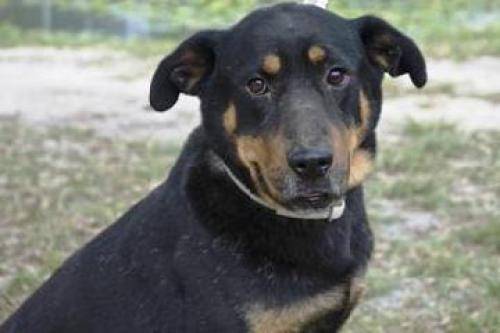
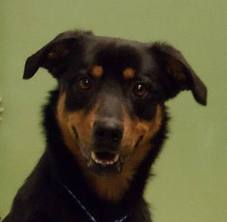
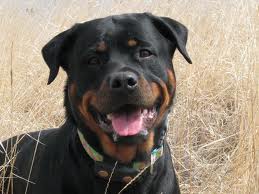
ABOVE: The first 2 females have what is commonly called “fly away ears”. Their ears are both incorrectly set and incorrectly carried. The male on the end in the green e-collar has correctly set ears, but they are incorrectly carried. They should be carried closer to his face.
BELOW: The male on the left has correctly set ears but his right ear is incorrectly carried. It should have been taped when he was younger. I really like the overall conformation of the pup on the right, however, his ears are set very high and will never be carried correctly.
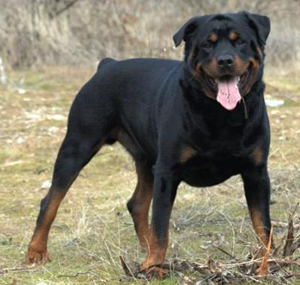
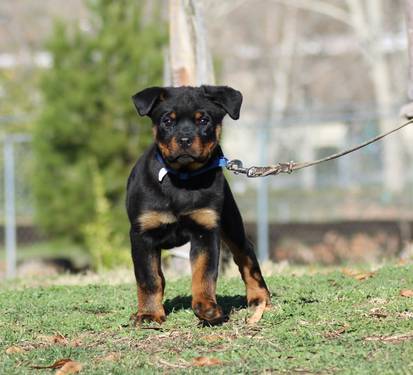
BELOW: Correctly placed and correctly carried ears give width and add to the power of the head no matter the sex or size of the Rottweiler. Both of these females have incredible head pieces, but the correct placement and carriage of their ears certainly enhances those heads.
Guardian Isis Von Gottschalk Guardian Akira Von Gottschalk
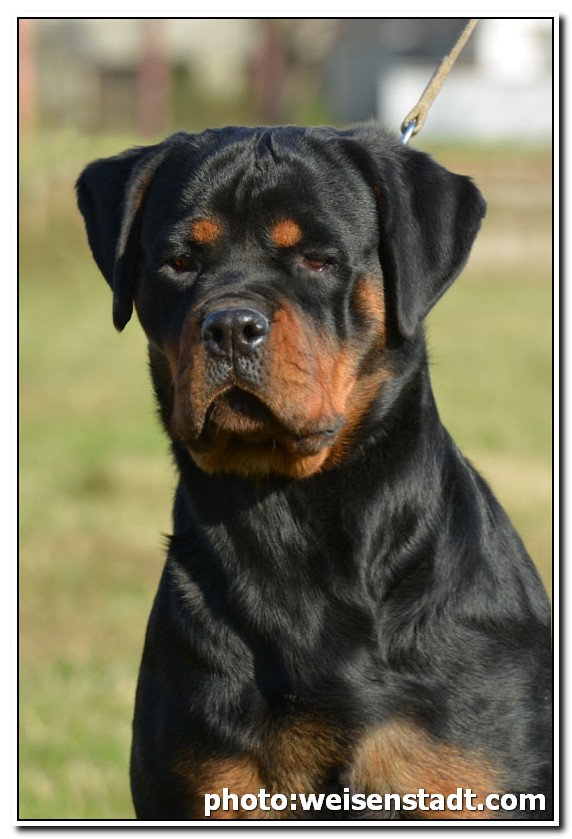
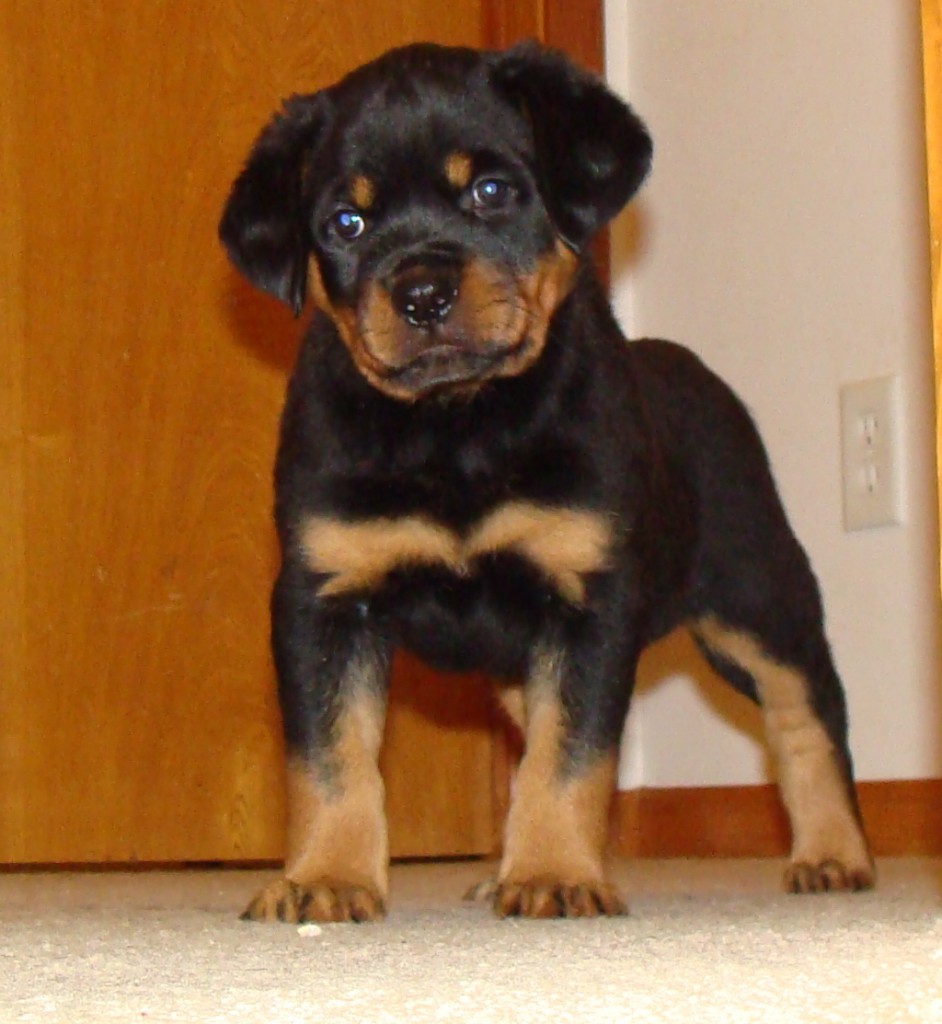
12. The topskull should have a moderate arch.

 Here are some examples of head types. Fig. 5- fig. 8 show correct Rottweiler heads with deep stop, full muzzles that are broad in the base with good fill in the zygomatic arch. Fig. 9-fig. 12 are all unfortunately common yet INCORRECT head types. Fig.9: Shallow zygomatic arch, narrow muzzle and shallow stop. Fig. 10: Nearly nonexistent stop, lacking fill under the eye and narrow at the base of the muzzle. Fig. 11: There is some zygomatic arch, but insufficient for muzzle width at base. Fig. 12: Shallow zygomatic arch with narrow, long muzzle. To emphasize the importance of the stop and zygomatic arch, despite how obviously wrong the head types are to even the untrained eye in fig. 9- fig. 11- all 3 of these heads are correct muzzle to topskull ratio and sufficient width of the topskull. It is the lack of stop and fill under the eye and insufficient power in the muzzle that prevent these Rottweilers from attaining that strong, masculine, head type. Correct head type is SO MUCH MORE than simply a short muzzle.
Here are some examples of head types. Fig. 5- fig. 8 show correct Rottweiler heads with deep stop, full muzzles that are broad in the base with good fill in the zygomatic arch. Fig. 9-fig. 12 are all unfortunately common yet INCORRECT head types. Fig.9: Shallow zygomatic arch, narrow muzzle and shallow stop. Fig. 10: Nearly nonexistent stop, lacking fill under the eye and narrow at the base of the muzzle. Fig. 11: There is some zygomatic arch, but insufficient for muzzle width at base. Fig. 12: Shallow zygomatic arch with narrow, long muzzle. To emphasize the importance of the stop and zygomatic arch, despite how obviously wrong the head types are to even the untrained eye in fig. 9- fig. 11- all 3 of these heads are correct muzzle to topskull ratio and sufficient width of the topskull. It is the lack of stop and fill under the eye and insufficient power in the muzzle that prevent these Rottweilers from attaining that strong, masculine, head type. Correct head type is SO MUCH MORE than simply a short muzzle.
One of my dear friends and well respected breeders in Italy told me one time, “size does not equal beauty” and I could not have said it better. Here in the US, I am not sure why we are so determined to make the Rottweiler a mammoth, fat, oversized, sloppy dog. He is a medium sized, compact, powerfully built machine. Oversizing him DOES NOT increase his beauty! It destroys his mechanics, decreases his lifespan, increases the likelihood of hip and elbow dysplasia and heart problems, and severely detracts from the compact, well muscled gorgeous dog his ADRK breed standard calls him to be. According to ADRK German Rottweiler Standards and even AKC Standards, the Rottweilers is a “medium sized, robust dog…” MEDIUM, NOT EXTRA LARGE! Here are a few examples where a higher number on the scale was the primary concern.
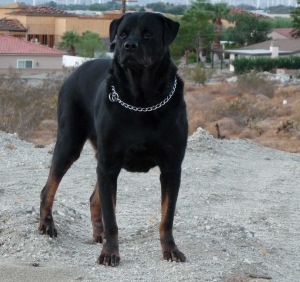
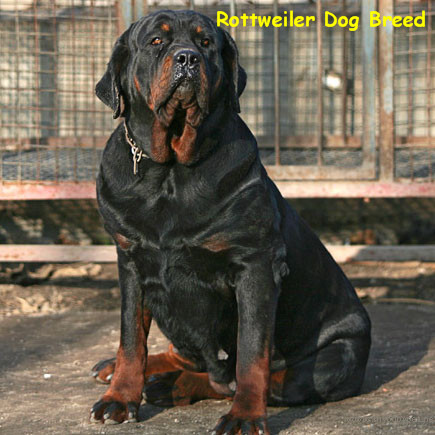
ABOVE: The first male looks almost absurd- this itty bity head on this long, leggy frame. His neck is 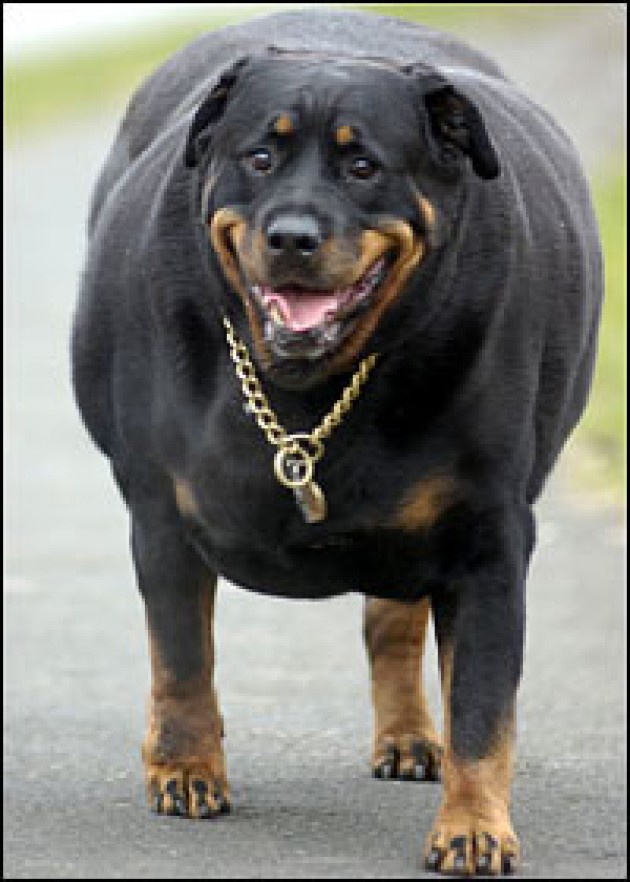 bigger than his head it! (My daughter said he looks like he went to see the witch doctor!) And the classic rich mahogany markings are almost non-existent due to all of the emphasis being placed on size and none on correct color or conformation. The second female is likely pregnant, however, still very poorly bred. She is very “wet” meaning there is a significant amount of extra skin. The Rottweiler is NOT a Mastiff or a Bloodhound. It should have a tight, well fitting skin and coat. It is almost certain that besides bird of prey eyes, this female likely suffers from entropion or ectropion.
bigger than his head it! (My daughter said he looks like he went to see the witch doctor!) And the classic rich mahogany markings are almost non-existent due to all of the emphasis being placed on size and none on correct color or conformation. The second female is likely pregnant, however, still very poorly bred. She is very “wet” meaning there is a significant amount of extra skin. The Rottweiler is NOT a Mastiff or a Bloodhound. It should have a tight, well fitting skin and coat. It is almost certain that besides bird of prey eyes, this female likely suffers from entropion or ectropion.
LEFT: Is this really what we want a Rottweiler to look like? Is the life and health of your dog of such little significance that it is more important to be able to say you have the biggest Rottweiler on your block? ADRK German Standards call for the male to be 50 kg- that is only 110 lbs! The bitch, significantly less! The Rottweiler is a powerful athlete, NOT a sumo wrestler!
Body Guardian Orion Von Gottschalk 
The neck should be strong and well muscled, slightly arched and free of throatiness or dewlap. In other words, you want the skin to be reasonably tightly fitting as the Rottweiler is NOT a Mastiff. The extra, droopy skin in the face and throat should not be encouraged in a breeding program as this is not the breed standard. The back should be “straight, strong, [and] firm” (ADRK Breed Standard), and he should have a solid topline without arching/roaching or dipping/swayback. The loin (lower back- lumbar vertebrae) must be “short, strong and deep”. (ADRK Breed Standard). The croup is “Broad, of medium length, slightly rounded. Neither flat nor falling away.” (ADRK Breed Standard) The top and bottoms lines are so important not only in the look of the Rottweiler but the function as well. When we discuss movement further down on this page, I will add both some pics and videos of correct vs. incorrect and you will see how the dog struggles when the body is not correctly put together. Function follows form! Guardian Isis Von Gottschalk  The Rottweiler’s chest is another crucial element in the function and powerful look of the Rottweiler. The chest should be wide and the ribs well sprung. The forechest should be well developed. The deep, wide chest should give substance to the Rottweiler’s stance and should be approximately half his shoulder height. The spacious chest houses the lungs of a powerful runner with relentless stamina. The Rottweiler’s flanks are located directly behind the ribcage. Because this breed should have a heavy, powerhouse build, the flanks are not tucked up. The Rottweiler’s tail should be an extension of the t
The Rottweiler’s chest is another crucial element in the function and powerful look of the Rottweiler. The chest should be wide and the ribs well sprung. The forechest should be well developed. The deep, wide chest should give substance to the Rottweiler’s stance and should be approximately half his shoulder height. The spacious chest houses the lungs of a powerful runner with relentless stamina. The Rottweiler’s flanks are located directly behind the ribcage. Because this breed should have a heavy, powerhouse build, the flanks are not tucked up. The Rottweiler’s tail should be an extension of the t opline. If it is set too high or too low, it will produce a break in the topline. The tail may be carried arched over the back or hang when the dog is relaxed. However, if the tail curls to the extent of crossing back on itself or the back, or if there is a strong lateral deviation (meaning the tail is carried to the side) then it will be a disqualifying fault. The tail is NOT to be docked. Not only is this banned in Germany, but your dog may not be show once the tail is docked, and per ADRK Breed Suitability Testing Regulations, if the dog is unable to place consistently in the ring, he will not qualify for breeding. (Please see Tale of Tails for more information on tail docking.) Limbs (ADRK Breed Standard)
opline. If it is set too high or too low, it will produce a break in the topline. The tail may be carried arched over the back or hang when the dog is relaxed. However, if the tail curls to the extent of crossing back on itself or the back, or if there is a strong lateral deviation (meaning the tail is carried to the side) then it will be a disqualifying fault. The tail is NOT to be docked. Not only is this banned in Germany, but your dog may not be show once the tail is docked, and per ADRK Breed Suitability Testing Regulations, if the dog is unable to place consistently in the ring, he will not qualify for breeding. (Please see Tale of Tails for more information on tail docking.) Limbs (ADRK Breed Standard)
Forequarters: Seen from the front, the front legs are straight and not placed too closely to each other. The forearm, seen from the side, stands straight. The slope of the shoulder blade is about 45 degrees to the horizontal. Shoulders: Well laid back. Upper arm: Close fitting to the body. Forearm: Strongly developed and muscular. Pasterns: Slightly springy, strong, not steep. Front feet: Round, tight and well arched; pads hard; nails short, black and strong. Hindquarters: Seen from behind, legs straight and not too close together. When standing free, obtuse angles are formed between the dog`s upper thigh and the hip bone, the upper thigh and the lower thigh and the metatarsal. Upper thigh: Moderately long, broad and strongly muscled. Lower thigh: Long, strongly and broadly muscled at top, sinewy. Hocks: Sturdy well angulated hocks; not steep. Hindfeet: Slightly longer than the front feet. Toes strong, arched, as tight as front feet. So, lets break that down. Front Assembly. .
Sorry, please forgive our mess. This page is still under construction.
